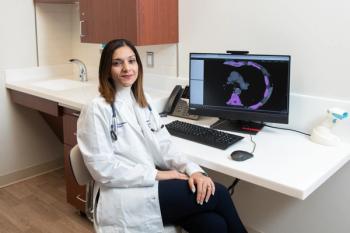
Aortic Aneurysm
Here are two cases that demonstrate the discovery of aortic aneurysms through careful and complete physical examination and via radiographic studies obtained to evaluate other conditions.
Here are two cases that demonstrate the discovery of aortic aneurysms through careful and complete physical examination and via radiographic studies obtained to evaluate other conditions.
Drs Mark Franco and Jerry Powell of the East Carolina University School of Medicine in Greenville, NC, report the case of a 63-year-old man who consulted his primary care physician after 2 months of weight loss, dysphagia, chest pain, and intermittent hemoptysis. The patient's past medical history was significant for chronic obstructive pulmonary disease and hiatal hernia, for which he was given omeprazole, 20 mg once a day.
A chest film revealed left hilar fullness, and a follow-up CT scan showed a superior mediastinal mass. A pulmonologist was consulted, and a biopsy of the mass was attempted, but the procedure was halted when the patient became hypotensive. He was transferred to the hospital for further evaluation.
At admission, the patient was afebrile, blood pressure was 142/76 mm Hg, heart rate was 83 beats per minute, and respiration rate was 18 breaths per minute. Head, ears, eyes, nose, and throat examination findings were normal; the neck showed no jugular venous distention; there was no adenopathy or thyromegaly, but the patient's left carotid pulse was weak. His lungs were clear bilaterally, but distant breath sounds were detected. Cardiac assessment revealed no gallops, murmurs, or rubs. Examination of the abdomen found no hepatosplenomegaly and positive bowel sounds. The extremities showed no clubbing, cyanosis, or edema. Neurologic and rectal evaluations were normal. Left radial and left brachial pulses were very weak. An MRI demonstrated a 5-cm aortic aneurysm displacing the subclavian artery (A).
A pathologic dilatation of a blood vessel, an aneurysm may be either a true aneurysm-disrupting all three layers of the vessel wall-or a pseudoaneurysm-a disruption of only the intimal and medial vessel wall layers. Aortic aneurysms may be classified as abdominal or thoracic; those that are abdominal usually involve an atherosclerotic process. Drs Franco and Powell write that there are familial clusterings in 20% of patients with abdominal aortic aneurysms, and a mutation of a gene encoding for type III procollagen has been implicated.1
Aneurysms of the ascending aorta may be secondary to cystic medial necrosis, atherosclerosis, bacterial infections, syphilis, rheumatoid arthritis, and trauma. Those of the descending aorta are usually associated with atherosclerosis. The patient may experience minimal symptoms, but aneurysm expansion can lead to pain and compression of adjacent structures. Thrombi may predispose to peripheral embolization. Extravasation of blood can cause local pain and tenderness.
Drs Franco and Powell stress that aortic aneurysms are a medical emergency and immediate surgery is indicated in the majority of patients. It is extremely important to perform a complete physical examination and to include even rare causes of the patient's symptoms in the differential.
Robert P. Blereau, MD of Morgan City, La, writes of an 85-year-old man who underwent a transurethral prostatectomy in the late 1970s and pelvic irradiation for prostate cancer in 1994. Three years later, the patient's prostate-specific antigen level was elevated to 13.1 ng/mL, which prompted a radiographic work-up. These studies revealed both a thoracic aortic aneurysm (B and C) and an abdominal aneurysm of the aorta (D).
Dr Blereau notes that this patient had no evidence of emboli, pain, or other symptoms associated with the aneurysms. His poor health status dictates conservative treatment for the aneurysms; he receives no medical therapy and is a poor surgical candidate. The prostate cancer is being controlled with an antiandrogen and a gonadotropin-releasing hormone analog.
REFERENCE:1. Harrison TR, Isselbacher KJ. Harrison's Principles of Internal Medicine. 13th ed. New York: McGraw-Hill Inc; 1994:1132.
Newsletter
Enhance your clinical practice with the Patient Care newsletter, offering the latest evidence-based guidelines, diagnostic insights, and treatment strategies for primary care physicians.

























































































































































































































































































